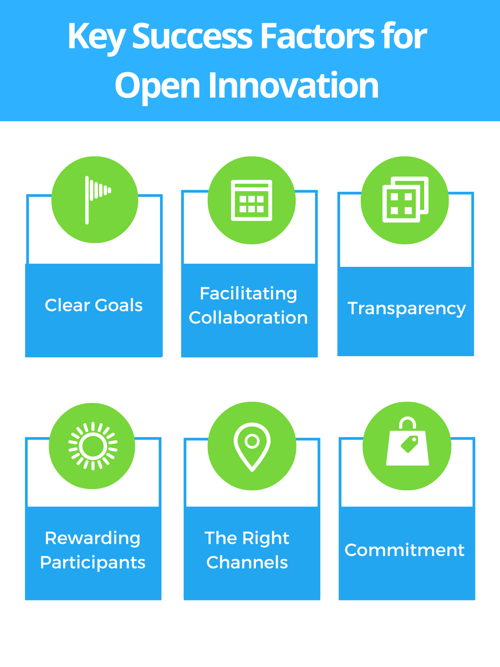6 Key Success Factors for Open Innovation
Open innovation is a trendy buzzword in the business world and there are plenty of sources that underline its importance and fundamentality for the future of businesses.
But how does one actually make open innovation work?
Open innovation enables success, yet without practical implementation there's very little benefit from open innovation. The execution, however, is what many businesses struggle with so that needs some further clarification. In the end, aren't the benefits what businesses should be most interested in?

Key Success Factors for Open Innovation
To take a step back here's a brief summary of the topic:
Open innovation is a modern paradigm that aims to achieve ideation and innovation in companies by using both external and internal sources of knowledge. Many believe that open innovation boosts innovation and R&D work in organizations. Successful cases include companies like LEGO, Samsung and GE.
Based both on our own experience working on open innovation with our customers, as well as the successes of some of the biggest companies in the world, I present 6 clear key success factors for open innovation in this post. To make each point concrete, the factors are accompanied with examples of how GE has done these in their operations.
1. Clear goals
Open innovation is most effective when it just becomes “the way things are done” in the organization. This requires open innovation to be a strong part of the company culture and strategy. Many experts emphasize the importance of knowing your goals towards open innovation, both on corporate and project level. On the higher level, open innovation processes and goals should be well defined. This builds trust as all members know how things are handled. This, in turn, helps when bumps occur in the collaboration since people know that even bad surprises won’t lead to them being thrown under the bus.
On a more practical level, it is important to clearly define the goals for open innovation. After all, reliable goals and timelines build trust in the collaboration. In practice, having clear goals means that you can answer the following questions:
- What are the objectives?
- Who owns the results of the project?
- What are the problems that open innovation should solve?
- What are the timelines and milestones for the project?
GE has innovation initiative challenges for just about anyone to participate in. Here are what the answers for the above questions could be for GE’s innovation initiative challenges:
- The objective is to gain new solutions for GE, these are developed based on challenge winning suggestions.
- The ownership of the submissions remains with the creator
- The problems are defined in the assignments, for example, Solving Scarcity Through Water Reuse case has a pretty clear problem definition
- The timelines and next steps for each of the challenges are communicated clearly for each initiative
2. Facilitating the collaboration
Facilitating the collaboration is the next vital part of successful open innovation. A natural way to start open innovation collaboration is to start with existing partnerships and networks. Utilizing existing connections makes open collaboration easy and fast to kick-off as there is already probably some existing collaboration and knowledge on one another, as well as trust between the parties.
Similarly, it is important to know your audience before starting. Who should you really collaborate with and in which case? Every stakeholder has their own perspective and areas of expertise, so having everyone involved at once isn't probably a good idea.
GE has, for example, a wide range of open innovation collaboration. Some are done directly with other companies and some with crowdsourcing platforms with just about anyone.
The projects and initiatives that GE has with its stakeholders are defined according to its target audience. For example, completely open challenges are not always related to specific R&D problems while some deeper crowdsourcing initiatives might end up with several ready products.
Activating the collaboration starts with bringing interesting questions on the table. Open innovation projects shouldn’t be too broad (save the world with our service) nor should the projects be too simple. Too broad projects might seem daunting and make the whole project a victim of procrastination. On the other hand, too simple projects won’t give participants room for creativity – or the positive surprises that the collaboration could generate! Interesting topics and well-defined problems are like to do well since they motivate people.
Initial ideas don’t usually generate much value in themselves, there needs to be professional guidance for the problem solving and discussion around the idea. Good facilitation encourages collaboration and supervises it the right way so that participation is both active and produces high-quality results!
3. Transparency
Transparency is a must in an open innovation organization as open innovation is transparent by definition. Being open about your problems and challenges can be difficult at first but can open doors for unexpected solutions to them. When others know about your struggles it is easier for them to come up with solutions designed exactly for you. There might even be competition among these different solutions.
GE’s open innovation manifesto is a great example of open innovation collaboration principles. Transparency is manifested there as a valuable enabler of open innovation collaboration. GE also reports its collaboration results on their website, which gives additional transparency and visibility to the collaborators.
Resnick says that transparency throughout the company boosts innovation, generates economies of scale and promotes collaboration and problem solving across company functions. Having clear procedures for both internal and external collaborators also enhances transparency, predictability, and trust.
Companies of course often have incentives to claim transparency, while knowingly concealing certain information such as current challenges or possible sources of competitive advantage. However, being secretive about these can often undermine the benefits of transparency. Collaboration should thus be genuinely open and transparent.
4. Rewarding Participants
One risk with open innovation collaboration is that the participants might not feel that they get something worthy out of it. It's important to understand that open innovation is not a way to get something without giving anything away. This is actually one of the central ways to motivate the participants.
Having said that, giving small scale monetary awards for groundbreaking innovations won’t probably be enough as "fair" compensation is needed. Furthermore, open innovation collaborators should have equal incentives but also bear some of the risks, which also motivates the collaborators.
To keep the collaboration flowing, you should try to avoid any ownership disputes, at least not before there really is something to dispute over. Just imagine how much of a buzz kill that can be for the whole initiative.
GE has very clear prizes for their innovation initiative challenges including internships, monetary prizes and presenting the winners name on GE’s website. In some cases the challenge winners are even invited to develop their ideas further with GE or as a part of GE. This kind of a career related reward is typically much more rewarding and motivating for an aspiring talent than mere monetary awards.

5. Find the Right Channels
Open innovation might often be good to start face-to-face. This is good for the initial pilot phase where different concepts and processes are tested, but in the long run, brainstorming and innovation face-to-face might be quite ineffective in solving problems. Online collaboration on the other hand, can really open up many possibilities.
Doing open innovation online has many pros. Online, you don’t need to think where and when people are available for your project. Collaboration can happen whenever, from wherever without the need to use a huge amount of effort to get people to the same place at the same time.
Working online also documents the whole innovation process automatically. This makes it easier to see what has already been done earlier.
Collaborating online means that at least some of the communication happens asynchronously. Hence, the ideal environment for innovation also integrates online components that take into account the asynchronous side of online collaboration.
Open innovation requires its own skillset, so it makes sense to provide open innovation teams and collaborators with information on open innovation best practices and familiarize them with the culture of open innovation.
However, when working online, there is no natural get-things-done mentality that builds up easily in face-to-face collaboration. Hence, creating a certain amount of urgency keeps things happening and diminishes waiting time in the project.
GE keeps a sense of urgency by having strict timelines for its innovation initiative challenges and crowdsourcing projects. There are set timelines for the challenges as well as the announcement of winners. As proof of the possibilities of online collaboration, GE has challenge winners from South Africa, Indonesia, and Poland. Clearly these people would have been hard to get to a face-to-face workshop.
6. Commitment
Finally, it is important to stick with what has been agreed on and to the goals that have been set. Open innovation shouldn’t be mere words without any action!
Building trust and working on the ideas from the collaboration naturally takes time. Likewise, visible results and profits come with time when things have actually been done. So better build the collaboration steadily, allocate enough resources and commit to the implementation. This creates trust, enthusiasm and a fertile base for a virtuous cycle of innovation.
As a proof of GE's commitment to their open innovation practices, they report the results of their collaboration online and announce new innovation initiatives on a regular basis. GE is also an advocating open innovation openly, which makes them clearly committed to the cause.
Maybe now you are also thinking of collecting ideas from outside your organization. To make it easier, we have designed an Open Innovation Board which will help you manage your open innovation initiatives in a user-friendly, intuitive and efficient manner. You sign up for free and start collecting and developing the most promising ideas right away!
This post is a part of our Open Innovation blog-series. In this series, we dive deep into the different areas of open innovation and cover the aspects we think are the most important to understand about open innovation.







.jpg)
